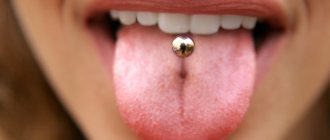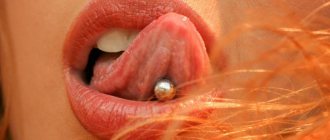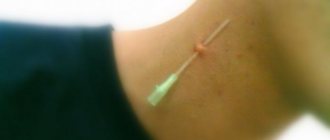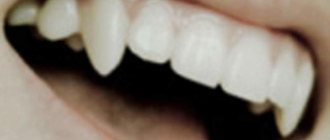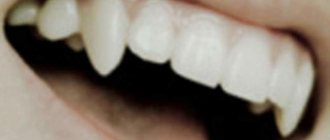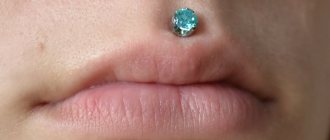The ancient ritual of sacrifice of the Mayan people and Australian aborigines has rapidly entered modern fashion. Information on how to pierce your tongue at home is available on the Internet. Knowledge of the rules, sequence of actions and methods of protection against inflammation and infections will help to carry out the procedure safely.
Whether it is worth piercing your tongue, for example, you need to decide for yourself, only knowing exactly the nuances of the procedure. Otherwise, it is better to get your tongue pierced in a professional salon, where specialists know exactly how to perform this mini-operation, how to numb the process as much as possible and not cause an infection.
Doubts and fears before the procedure
People who decide to have home piercings are overcome by doubts and fears regarding possible pain in the oral cavity. The use of analgesics will make the process painless, however, when their effect stops, the pain will remain until the wound is completely healed. Therefore, when asked whether it hurts to pierce your tongue, you can answer that it is quite tolerable. The procedure depends on personal sensitivity to pain and mood. The procedure can be compared to a cosmetic ear piercing.
Accurate knowledge of how to pierce the tongue is necessary. If the procedure is carried out at home, then the attitude towards hygiene and sterilization of piercing instruments should be increased. In this case, it will be possible to avoid infection and inflammatory processes, which are unlikely to be dealt with on your own; emergency medical attention will be required.
Does it hurt to pierce your tongue?
According to reviews from those who have undergone the operation, the puncture itself is a matter of seconds, quite tolerable. It will hurt later, during healing. The tongue is highly sensitive. Because this organ is in constant motion, with a wound in the middle, it will hurt until it heals completely. To reduce pain:
- have the operation performed by a trusted specialist;
- care for the wound;
- do not smoke;
- do not drink alcohol;
- talk less at first;
- Avoid hot, spicy foods.
Tools
To pierce the tongue, you need a set of sterile instruments, including:
- decoration: a rigid rod consisting of a rod with a rounded cross-section, onto which elements are screwed on both sides: stones, cones, spikes. The jewelry is made of surgical steel, titanium, Teflon or gold. The rod comes with internal and external threads, its length ranges from 1.5 to 3.5 cm;
- a clamp for holding the tongue, instruments of this type are usually used by surgeons, the clamp is made of stainless medical steel;
- piercing catheter or cannulated instrument: a needle that is empty inside, made in different diameters. The needle is laser sharpened, so tongue piercing at home is performed with maximum comfort and safety. The diameter of the catheter should be larger than the diameter of the selected jewelry, then repeated manipulations will not be required;
- sterile gloves that will ensure a secure grip on instruments and protect against infections;
- preparations for disinfection: Miramistin or Chlorhexidine.
How to pierce your tongue?
We take the tongue in a clamp and insert a needle-catheter into the puncture point under the tongue. Place the tongue with the clamp on the chin and remove the needle. This way the channel is inclined. The puncture is carried out from bottom to top. The earring is inserted into the tube from the catheter in the same way - from bottom to top. After the procedure, the mouth should be rinsed again with a solution of 3% hydrogen peroxide (diluted 1:1 with water).
Caring for the puncture site: healing and formation of the channel takes 2-3 weeks. Provide the client with post-tongue piercing care instructions.
Step-by-step instruction
Step-by-step instructions will tell you how to pierce your tongue correctly and almost painlessly. However, before studying it, it is important to know some rules for this mini-operation planned at home.
First you need to understand where, in what place you can pierce your tongue. Piercing is done exclusively on the tip of the tongue or strictly in its middle. If the puncture is made along the edges, then there is a high probability that the needle will get into large arteries, and it will be difficult to stop the bleeding.
If there are concerns that piercing your tongue will be painful, then you can resort to analgin or No-shpe. These drugs can make manipulation easier.
- Sterilize all instruments, including jewelry, with special products or medical alcohol.
- Rinse your mouth thoroughly using antibacterial or mild saline solutions.
- Wash your hands thoroughly with antibacterial soap, then put on sterile gloves.
- Holding your tongue with a clamp, mark the place for the puncture.
- Make a puncture with a hard movement. Using a catheter, the puncture is made from below, using a regular needle from above. Videos about how to pierce the tongue in one way or another can be found on the Internet.
- Insert the earring using a catheter or normal movement. The earring is inserted without delay, since within a few hours the wound will begin to heal and a new puncture will have to be made.
- Rinse your mouth thoroughly with an antiseptic.
Tongue piercing
Risks of infection
If you pierce yourself, the risk of infection of the piercing increases. There is a high probability of damage to tooth enamel from metal jewelry on the tongue. Impairments in clarity of pronunciation and taste are also possible.
But, as a rule, no nuances can stop a determined person. Therefore, before you begin the “operation”, it’s time to purchase jewelry. At first, a long barbell is best because the tongue will be swollen for some time. Then, as the swelling subsides, it can be replaced with a shorter, flexible plastic product.
To avoid infection of the wound, you should buy sterile gloves, cotton wool, tampons and an IV system (we will need a sterile, sharp and hollow needle from it). Also, medical alcohol is useful for sterilizing a barbell, and Miramistin is useful for treating piercings. And just in case, you need to buy an antiseptic ointment.
Since the tongue is always wet and slippery, it will be difficult to hold it with your hand during a puncture. Therefore, it is worth investing in the purchase of special forceps. If these are not available, you will have to use improvised means in the form of an ordinary clothespin.
Possible complications and problems
Knowing how to safely pierce your tongue at home can minimize unwanted consequences. However, they may still appear. If the puncture site is chosen incorrectly, the jewelry may not take root. The puncture site will constantly swell and hurt, creating inconvenience when eating.
In any case, the consequences of tongue piercing performed at home will be an uncomfortable sensation in the mouth for some time. For about two weeks, only soft and liquid food is taken. Diction is disrupted, decoration gets in the way and is difficult to get used to.
In some cases, the bar, constantly in contact with the teeth and gums, can knock off the enamel from the teeth and injure the gums.
How much does a tongue piercing cost?
To make jewelry bring joy and not darken your life, go to a salon or medical facility. Many clinics offer tongue piercing services, here is an overview of the cost of the procedure in Moscow institutions:
| Name of institution | Cost, rubles |
| Family doctor | 1 800 |
| Etisel | 2 200 |
| World of beauty | 1 500 |
| Hippocratic Oath | 2 000 |
| EkaMed | 1 500 |
Care after a piercing
After a puncture, care should be aimed at speedy healing of the wound. The mouth constantly produces antimicrobial peptides that kill harmful bacteria. However, you should not rely on them alone; additional measures are also needed for healing.
- Avoid alcohol and smoking, as the tar contained in cigarettes and the ingredients in alcoholic beverages will delay the healing process.
- Avoid viscous, hard and spicy foods, fermented milk and sweet products.
- Rinse your mouth with warm saline solution and antiseptic Listerine or Miramistin.
- Postpone kissing for a while, as there is a risk of infection.
Understanding how to properly pierce your tongue will help you perform this small and, in every sense, rather risky operation successfully. The choice of where to hold it, at home or in a salon, remains with the person who wants to be unusual and sexy, standing out in the crowd. In any case, ensuring safety and maintaining health should be the deciding factors for a person who decides to get a piercing.
How to avoid pain and care in the first days
The main question for future owners of extreme piercings is whether it hurts to pierce your tongue? It is impossible to answer the question unambiguously, since each person has his own pain threshold. In salons, everything goes quickly and there is no pain relief, but at home you inject yourself and the process can take several minutes, which means you won’t be able to avoid the pain. A small amount of lidocaine applied to the tip of the tongue will help reduce sensitivity.
In the post-procedural period, cold compresses will help reduce discomfort. You can rinse regularly with cold, clean water or apply ice. These measures are also good for removing swelling that will be observed in the first few days.
Care:
- For several hours after the procedure, it is prohibited to drink alcohol, eat, or smoke.
- Rinse your mouth with a disinfectant solution 2 times a day.
- During complete healing, avoid spicy, salty, hard, and hot foods. Do not drink colored drinks or coffee.
- It is forbidden to kiss until the wound heals.
Following the recommendations depends on the speed of healing of the puncture and the risk of developing inflammation and infections. The mouth is the most difficult area for a piercing to implant, so be careful to keep it sterile.
How to choose a professional piercer?
If you find it difficult to choose a specialist, you can call several of them in advance and ask leading questions. They will allow you to find the most qualified master. He will puncture without risking your health. Remember, the best specialist is the one who avoids all danger.
First, ask how much experience the person has. If no more than three years, then you can call further. Next come the most important questions: how the puncture is made and under what conditions the instruments are sterilized. The only correct answer in this case: after cleaning and disinfection, sterilization occurs only in an autoclave, and disposable needles are used to make a puncture. Be sure to ask if anesthesia is used for this procedure.
A true master will absolutely confidently answer “no.” Well, in the end you need to ask about the decoration and the possibility of replacing it. A specialist who knows his craft first uses a titanium rod 18-22 mm long. In a few months it will be possible to replace it with a shorter one. If the answers to all the questions satisfy you, you can consider that you have found your master.
More on the topic: Nose piercing
Here are some more useful tips for choosing a qualified piercing studio:
- It makes sense to ask friends or acquaintances who have undergone a similar procedure to recommend a specialist or studio for such an operation.
- Directly in the studio, pay attention to hygiene supplies and, in general, the conditions for piercing the tongue. Check with a specialist for the details of sterilizing instruments. He will be happy to tell you about these details. It would be a good idea to ask whether medical staff use disposable gloves.
- Under no circumstances should you hesitate to ask to see the appropriate certificate. This is an important document and its absence should make you seriously doubt the studio's qualifications.
- You should also find out whether the employees directly performing the piercing procedure are vaccinated against hepatitis B.
If your demands and questions are answered with reluctance, trying to hide important facts, it is advisable to contact another piercing studio.
The history of piercing
For the first time, residents of African tribes and Polynesia began to practice the procedure of piercing various parts of the body. The Maasai were the first to introduce various decorations into their ears and lips. At that time, it was believed that the larger the size of the jewelry in the body, the greater the “weight” a person had in the tribe.
Navel piercing first appeared in Egypt. Women loved this procedure very much. The presence of a hole in the navel area of the Egyptian woman indicated that she belonged to “high society.”
In Tsarist Russia, sailors preferred to pierce their earlobes and wear voluminous earrings. Such a “symbol” meant that the person crossed the equator or belonged to the Cossack family. Later, starting in the 80s, it became fashionable for rappers to pierce their earlobes.
Nose piercing first appeared in India. The presence of a septum piercing (a puncture of the nasal septum) in a woman indicated her marital status, that is, that the girl was married.
Nipple piercings were done by warriors of Ancient Rome. An earring in a man's nipple indicated his masculinity, courage and determination. Only the strongest and bravest warriors had the right to have nipple piercings. Those with nipple earrings regularly competed in strength and courage. In order not to damage the “decoration”, special fabric capes were worn over the earrings.
The ancient Aztecs and North American tribes first began piercing their tongues. They carried out the procedure consciously, since it was considered a magical rite that helped to reunite with the Gods. The protruding blood on the tongue was considered sacred; it served as a means of calming the Spirits.
These days, piercings have completely different purposes. By piercing various parts of the body, people want to show their individuality, attract attention or stand out. For some, piercing is a way to feel new emotions, to prove to themselves that they can overcome pain and, as it were, move to a “new level of development.”
Why do you need to clean your tongue?
The benefits of tongue cleaning will be noticeable if the procedure is carried out regularly and correctly. Such care is especially important if there is a thick, dense coating of yellow, gray or brown color that has an unpleasant odor. These signs may indicate:
- infectious diseases - sore throat;
- fungal infections of the oral mucosa - candidiasis;
- pathologies of the digestive system;
- disorders of intestinal microflora;
- helminthic infestations;
- long-term use of certain medications;
- unbalanced diet;
- insufficient oral care.
Cleaning not only provides a fresh smell, but also gets rid of many pathogens. Its regular implementation allows you to get rid of tartar and other dental diseases. The procedure stimulates the functioning of internal organs and helps to better perceive the taste of food dishes.
Types of special needles for piercing
Piercing is a popular procedure that involves making a puncture on a specific area of the body where jewelry is inserted.
To carry out a puncture in the skin, various tools are used, among which the main ones are high-quality piercing needles https://pierceandstud.ru/igly_dlya_pirsinga/. Thanks to them, the procedure is quick and almost painless.
Types of needles
There is a wide variety of needles that have different diameters and purposes. Below are the types of piercing needles that are most often used for the procedure.
Designed for piercing the ears and nose. It is worth noting that these types of piercings are the most popular among many people. The instrument used to perform the puncture has an internal diameter of 0.8 mm.
This type of needle has diameters of 1.4 mm and 1.2 mm. These sizes also allow this needle to be used for nose and ear piercings. Nose piercing is carried out in different parts, for example, on the bridge of the nose or the tip, and have different decorations. Using this needle, the earlobe, cartilage, outer part of the ear or the helix of the auricle can be pierced.
It is a tool whose outer and inner diameters are 2 and 1.6 millimeters. With the help of such a needle it is convenient to pierce the eyebrows. The decoration can be placed in different places, for example, above the eyebrow, and at different angles. It is worth noting that the choice of location is determined not only based on individual wishes, but also on physiological characteristics.
Thanks to the sizes of 2 and 1.4 mm, piercings are carried out in the navel, tongue and nipples. Instruments for these types of piercings have a catheter that allows you to insert the jewelry into the hole.
This type of special needle is mainly used for setting tunnels. This is due to the size of the instrument, which has an outer diameter of 4 mm and an inner diameter of 3.8 mm. The procedure for installing tunnels involves making a hole for decoration, which will gradually stretch to the required size.
Piercing should be performed only with high-quality needles that are made of material that does not cause an allergic reaction or irritation. It is worth noting that not only the piercing process, but also the further healing of the wound depends on the instrument used.
Source

